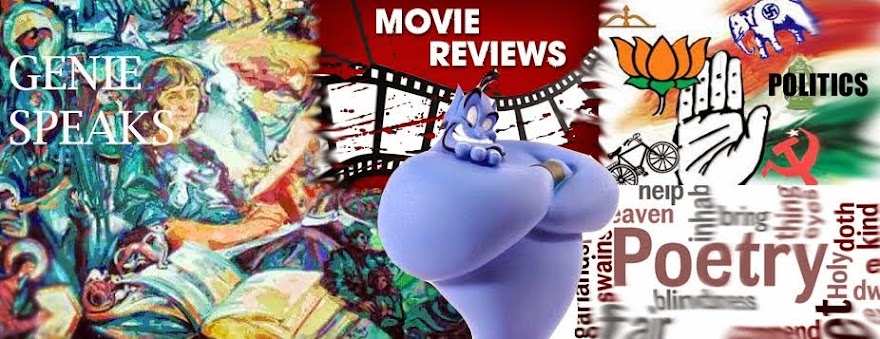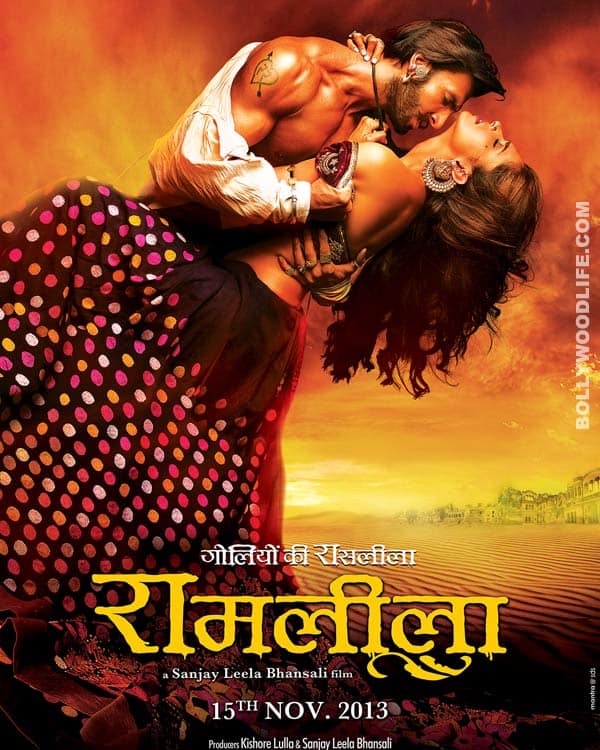Sanjay Leela Bhansai has grown so much today and that seems to be the high point of this movie. In his earlier romantic ventures all we could connect to were the ubiquitous shades of blue. There was such colossal and conspicuous use of the color 'Blue' in his earlier romantic escapades that children had stopped asking the question why the sky looked blue? In Ram-Leela, he has apparently moved on and has given screen space to all the other colors. Chromatic secularism, one might say!
Long before the release, the word had already spread that this is a adaptation of the bible of love, Shakespeare's Romeo & Juliet. And those who had no idea, the initial credits indicate the influence. This in a way gives the whole theme and climax out at least for those who know the tragic love story. Nevertheless, it turns out to be a little different and of course colored with the Bollywood masala and songs. Now one of the things with love stories is that, the audience needs to bond with both the protagonists and the love should grow gradually and not within a span of three screens. Only then, we connect to their love, their pain and their agony. But unfortunately that would not happen here, you would find yourself more fascinated by other supporting characters.
The movie is based in a vintage Rann of Kachch village where there are two clans having bad blood between them and have been fighting since the last 500 years and desperately waiting for some cross couple to fall in love to that the hatred could subside. The village's economy is entirely based on the selling of guns and ammunition and everyone in the villages keeps a ghoda with them irrespective of age and gender. You feel like you are wandering in the imagination of Mao Zedong where power flows from the barrel of the gun. Ranveer Singh (Ram) belongs to the head family of one clan and is the Hugh Hefner of the clan not indulging in any gun action and more into the hot chikkas of the countryside. Our playboy believes that the bad blood between the clans should end so that they could have access to the ultra-hot gals of the other clan.
And this is how he meets Leela when he trespasses into the rival zone on the colorful day of Holi. No prizes for guessing who she is! Of course she would be the gorgeous single and available daughter of the head family of rival clan. And then, instant impact! They fall in love and start making out at the blink of an eye. Gosh, I have seen forward people but this was supposed to be a vintage setup for crying out loud. Anyways, Deepika (Leela) is getting hotter by the day, a sure sign of global warming! Then rest of the plot is anybody's guess. The climax is little different then what you would presume and the formula of unrequited love is kindda evergreen.
Talking of performances, Ranveer's six packs have put up a firm performance, rest of him not so much. Surprisingly Deepika has delivered a flawless performance as a chulbuli hottie at first and then a firm lover later on and the transformation she brings is fabulous. But for me its the support cast that shines brighter with mind blowing performances from mainly Supriya Pathak and also Richa Chadda. They shape the real leela of the movie. The songs are not that great barring the happening item from our heartthrob Priyanka but the background score and cinematography is commendable. SLB definitely has potential but here that could not be transformed into frames. And also SLB, it would have been better to cast someone else for Ram, someone who does not look like Hanuman!
Nothing new, watch it for unrequited love, Deepika and Supriya!
Long before the release, the word had already spread that this is a adaptation of the bible of love, Shakespeare's Romeo & Juliet. And those who had no idea, the initial credits indicate the influence. This in a way gives the whole theme and climax out at least for those who know the tragic love story. Nevertheless, it turns out to be a little different and of course colored with the Bollywood masala and songs. Now one of the things with love stories is that, the audience needs to bond with both the protagonists and the love should grow gradually and not within a span of three screens. Only then, we connect to their love, their pain and their agony. But unfortunately that would not happen here, you would find yourself more fascinated by other supporting characters.
The movie is based in a vintage Rann of Kachch village where there are two clans having bad blood between them and have been fighting since the last 500 years and desperately waiting for some cross couple to fall in love to that the hatred could subside. The village's economy is entirely based on the selling of guns and ammunition and everyone in the villages keeps a ghoda with them irrespective of age and gender. You feel like you are wandering in the imagination of Mao Zedong where power flows from the barrel of the gun. Ranveer Singh (Ram) belongs to the head family of one clan and is the Hugh Hefner of the clan not indulging in any gun action and more into the hot chikkas of the countryside. Our playboy believes that the bad blood between the clans should end so that they could have access to the ultra-hot gals of the other clan.
And this is how he meets Leela when he trespasses into the rival zone on the colorful day of Holi. No prizes for guessing who she is! Of course she would be the gorgeous single and available daughter of the head family of rival clan. And then, instant impact! They fall in love and start making out at the blink of an eye. Gosh, I have seen forward people but this was supposed to be a vintage setup for crying out loud. Anyways, Deepika (Leela) is getting hotter by the day, a sure sign of global warming! Then rest of the plot is anybody's guess. The climax is little different then what you would presume and the formula of unrequited love is kindda evergreen.
Talking of performances, Ranveer's six packs have put up a firm performance, rest of him not so much. Surprisingly Deepika has delivered a flawless performance as a chulbuli hottie at first and then a firm lover later on and the transformation she brings is fabulous. But for me its the support cast that shines brighter with mind blowing performances from mainly Supriya Pathak and also Richa Chadda. They shape the real leela of the movie. The songs are not that great barring the happening item from our heartthrob Priyanka but the background score and cinematography is commendable. SLB definitely has potential but here that could not be transformed into frames. And also SLB, it would have been better to cast someone else for Ram, someone who does not look like Hanuman!
Nothing new, watch it for unrequited love, Deepika and Supriya!




